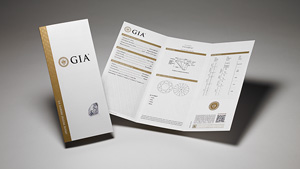Diamond Grading Reports & Certifications
Diamond Reports, also known as Diamond Certifications, are documents that define the unique characteristics of individual diamonds in a universal and understood "language". These documents are assigned by many laboratories that employ teams of gemologists to examine each individual stone with advanced techniques and equipment.
The "language" utilized today to describe the visual aspects and additional attributes of a diamond were developed by the Gemological Institute of America (GIA), allowing professionals and consumers the ability to understand the factors that may effect the overall look of the diamond, as well as to understand whether or not any treatments are present and whether or not the diamond is natural or synthetic.
While diamond certification doesn't neccesarily dictate the value of an individual diamond, it does effect the conceived perception of the diamonds actual quality, which depending on the particular laboratories consistency and reputation can mean a large difference in the price paid at the time of purchase.
Many major laboratories exist in many countries around the world, and while most practice and operate under sound ethics and standards, certain laboratories who struggle to find a place in the industry, have been known in the past to bend the standards of diamond grading and have in-turn gained a reputation for over-grading diamonds.
Below we explain the different laboratories and their places within the diamond industry.
GIA
The global standard
The industry leader, Gemological Institute of America, founders of the universal language of diamond grading and innovators in technology and research, GIA is known for their historically strict grading standards, ensuring each diamond is accurately described within the highest rate of consistency.
Diamonds graded by GIA are done so anonymously, where graders and clients, never have the opportunity to interact, while up to 5 separate graders come to an agreed conclusion as to what the diamonds unique characteristics are, leaving the consumer with a true unbiased report on their diamond.
As a non-for-profit, GIA leads the industry in research and development, bringing forward new techniques and equipment to better test, detect and grade diamonds their treatments and other unique characteristics.
Also known for their education, GIA is the main school for individuals looking to become Graduate Gemologists, or those who grade and certify diamonds.
A GIA Diamond Grading Report removes arguments from conversations and dealings among the most experienced professionals in the diamond trade, while people base decisions on multi million dollar sales on GIA's opinion.
EGL
KNOWN FOR OVER GRADING
* It is important to understand the laboratories that are grading or certifying diamonds. A simple search of " EGL overgrading " or “ EGL vs GIA ” , will return detailed information about this laboratory's history and reputation. *
The European Gemological Laboratory, has been known to stretch the boundaries beyond human error or random mistakes, and has utilized the diamond grading "language" created by GIA in a negative manner, by assigning specific designations to diamonds with evidently worse qualities.
For example, a 1.00 carat diamond of J color and SI2 clarity, according to GIA standards, may receive a grading of G color and VS2 clarity at EGL laboratories.
This leads the consumer to believe a false sense of value or discount at the time of purchase, assuming they are receiving something that if graded by GIA would have the same characteristics.
Do to this fact, EGL has since ended operations in many of the countries that their labs operated in, and their certifications have been banned from major diamond industry trading platforms.
IGI
The International Gemological Institute, based in New York, NY is a laboratory that can go back and forth on with similar grading to GIA. The grading by IGI can occasionally be more strict while the certification is held at a slight less regard among professionals in the diamond trade. IGI does offer grading in mounted diamonds, which can lead to misgrading and a less effective way of identifying the true color and clarity of a diamond.
AGS
AGS, the American Gemological Services laboratory based in Las Vegas, NV is know for their strict grading of diamond cut characteristics, with limits on the mechanical grading devices harsher than that of GIA. AGS falls into a category of laboratories that are known to occasionally be just slightly more lenient than GIA.
HRD
A European laboratory based in Antwerp, Belgium, HRD is a laboratory with a scientific approach to the grading and identification of diamonds and new treatments and techniques. Their certifications are held in accord with IGI and AGS and have been known on occasion, to be ever slightly more lenient than GIA.







